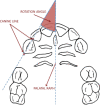Maxillary canine retraction with self-ligating and conventional brackets
- PMID: 21208082
- PMCID: PMC8925270
- DOI: 10.2319/062510-348.1
Maxillary canine retraction with self-ligating and conventional brackets
Abstract
Objective: To measure space closure during the retraction of upper permanent canines with self-ligating and conventional brackets.
Materials and methods: Fifteen patients who required maxillary canine retraction into first premolar extraction sites as part of their orthodontic treatment completed this study. In a random split-mouth design, the retraction of upper canines was performed using an elastomeric chain with 150 g of force. The evaluations were performed in dental casts (T0, initial; T1, 4 weeks; T2, 8 weeks; T3, 12 weeks). The amount of movement and the rotation of the canines as well as anchorage loss of the upper first molars were evaluated.
Results: There was no difference between self-ligating and conventional brackets regarding the distal movement of upper canines and mesial movement of first molars (P > .05). Rotation of the upper canines was minimized with self-ligating brackets (P < .05).
Conclusion: Distal movement of the upper canines and anchorage loss of the first molars were similar with both conventional and self-ligating brackets. Rotation of the upper canines during sliding mechanics was minimized with self-ligating brackets.
Figures




Comment in
-
Re: Maxillary canine retraction with self-ligating and conventional brackets. A randomized clinical trial. By: Maurı´cio Mezomo; Eduardo S. de Lima; Luciane Macedo de Menezes; Andre’ Weissheimer; Susiane Allgayer. Angle Orthod. 2011;81:292–297.Angle Orthod. 2011 Sep;81(5):926-7; author reply 927. Angle Orthod. 2011. PMID: 21991596 No abstract available.
References
-
- Elias C. N, Lopes H. P. Materiais Dentários Ensaios Mecânicos. São Paulo, Brazil: Ed. Santos; 2007.
-
- Hain M, Dhopatkar A, Rock P. The effect of ligation method on friction in sliding mechanics. Am J Orthod Dentofacial Orthop. 2003;123:416–422. - PubMed
-
- Hain M, Dhopatkar A, Rock P. A comparison of different ligation methods on friction. Am J Orthod Dentofacial Orthop. 2006;130:666–670. - PubMed
-
- Khambay B, Millett D, McHugh S. Evaluation of methods of archwire ligation on frictional resistance. Eur J Orthod. 2004;26:327–332. - PubMed
-
- Baccetti T, Franchi L. Friction produced by types of elastomeric ligatures in treatment mechanics with the preadjusted appliance. Angle Orthod. 2006;76:211–216. - PubMed
Publication types
MeSH terms
LinkOut - more resources
Full Text Sources

